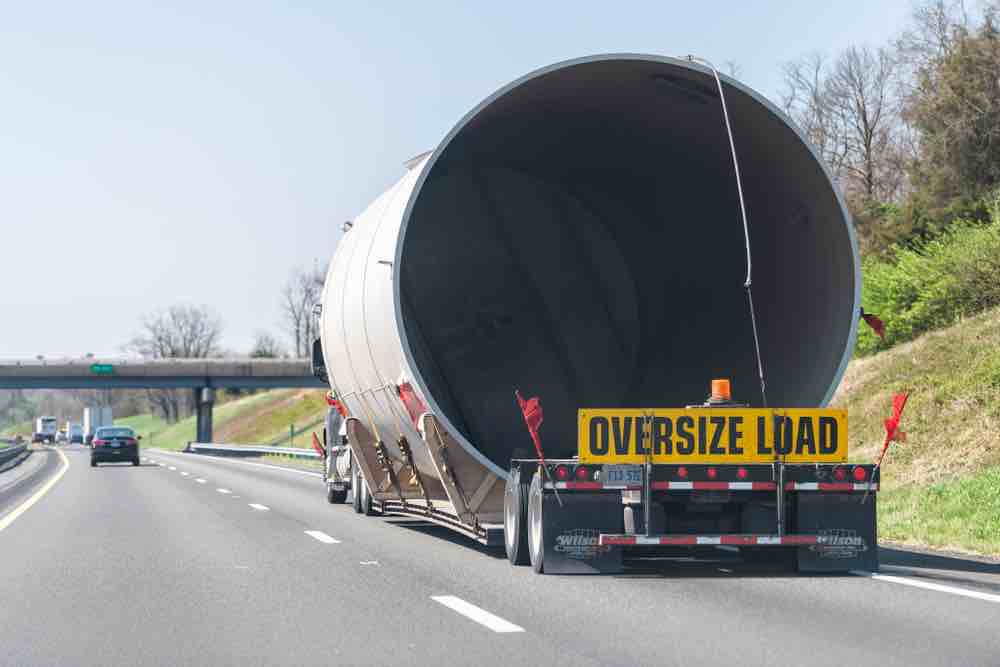
 Request FREE consultation - 1866-758-4529
Request FREE consultation - 1866-758-4529 
Oversized loads are those that require extra precaution and planning to transport them safely through Texas. Yet, oversized loads caused many accidents for various reasons. In this post, we will explore the transportation of oversized loads and related matters.
Oversized loads refer to cargo that exceeds the standard legal size or weight limits for transportation on roads. These loads are either large, heavy, or challenging to maneuver. The dimensions of an oversized load can vary, but they will exceed the following standard dimensions:
There are many different types of oversized loads. Typical loads include materials for construction, manufacturing, energy, and even housing. You can frequently see heavy machinery, windmill blades, or even manufactured modular homes being transported by a large truck
Large loads create various challenges for the truck driver and the motoring public. Here are a few of those challenges:
Large loads are much more difficult to maneuver through traffic. Changing lanes and even stopping can take much longer with an oversized load.
One factor that is evident in many accidents where a large load is involved is the fact that the large truck and its cargo are a visibility problem for other motorists. This risk is enhanced on Interstate highways and other freeways. The load itself can block the view of other drivers, increasing the chance of accidents.
Oversized loads can cause substantial damage to roads and bridges, leading to costly repairs. Their size can also lead to collisions with overhead structures like bridges or power lines, causing further damage and potential traffic incidents.
Large loads typically travel at a slower rate of speed that tends to impede the flow of traffic and cause congestion. Even when the truck driver has others traveling behind it, the issue remains that traffic is impeded, resulting in many crashes.
Transporting oversize loads in Texas is heavily regulated to minimize the associated risks. These regulations include requirements for special permits, pilot cars, and specific route planning. Key regulations often include:
– Maximum allowable dimensions and weight
– Mandatory use of pilot cars for certain loads
– Specific route planning and timing restrictions
Pilot cars are essential for the safe transportation of oversized loads. They serve as an advanced warning to other road users about the approaching oversize load and help guide the truck driver, alerting them to potential hazards or obstacles on the route.
Route planning ensures that the chosen route can accommodate the size and weight of the load. It helps avoid areas with heavy traffic or low-hanging structures, reducing the risk of accidents and delays.
Although oversize load accidents are not as frequent as regular traffic incidents, they often result in significant property damage, injuries, and even fatalities. Key statistics include:
Several high-profile cases highlight the dangers of oversized load transportation. For example, the 2013 Skagit River Bridge collapse in Washington State was caused by an oversize load striking part of the bridge structure. This incident resulted in injuries, a fatality, and significant legal implications, with the trucking company being found liable for negligence in route planning.
Transporting oversize loads safely requires adherence to best practices, including meticulous route planning, regular equipment maintenance, and continuous driver training.
Selecting the safest and most efficient route for the oversize load involves considering factors such as road conditions, bridge clearances, and traffic patterns.
Regular checks and maintenance of the vehicle and its equipment ensure that the vehicle is in good working condition and reduce the risk of mechanical failures.
Drivers must possess the necessary skills and expertise to handle the unique challenges posed by oversized loads. This includes understanding how to maneuver the vehicle, respond to unexpected situations, and comply with all relevant safety regulations. Continuous training and education are key to maintaining these skills and staying updated on the latest safety practices.
Advanced driver assistance systems (ADAS) can help drivers navigate safely and efficiently. Regular maintenance of vehicles and equipment, including checking the condition of tires, brakes, and other critical components, ensures reliability and reduces the risk of accidents caused by equipment failure.
The transportation of oversized loads presents unique challenges and risks. However, with proper planning, training, and adherence to safety regulations, these risks can be significantly mitigated. Safety and compliance are paramount in oversize load transportation, protecting drivers and the public and ensuring the efficiency and reliability of the transport industry in Texas.
Contact our truck accident law firm in Houston for help with your truck accident case.
Accidents caused by oversize loads
Wide and oversize loads in texas
Fatal Bridge Accident with Big Rig – No Oversize Permit
When oversize loads cause damage